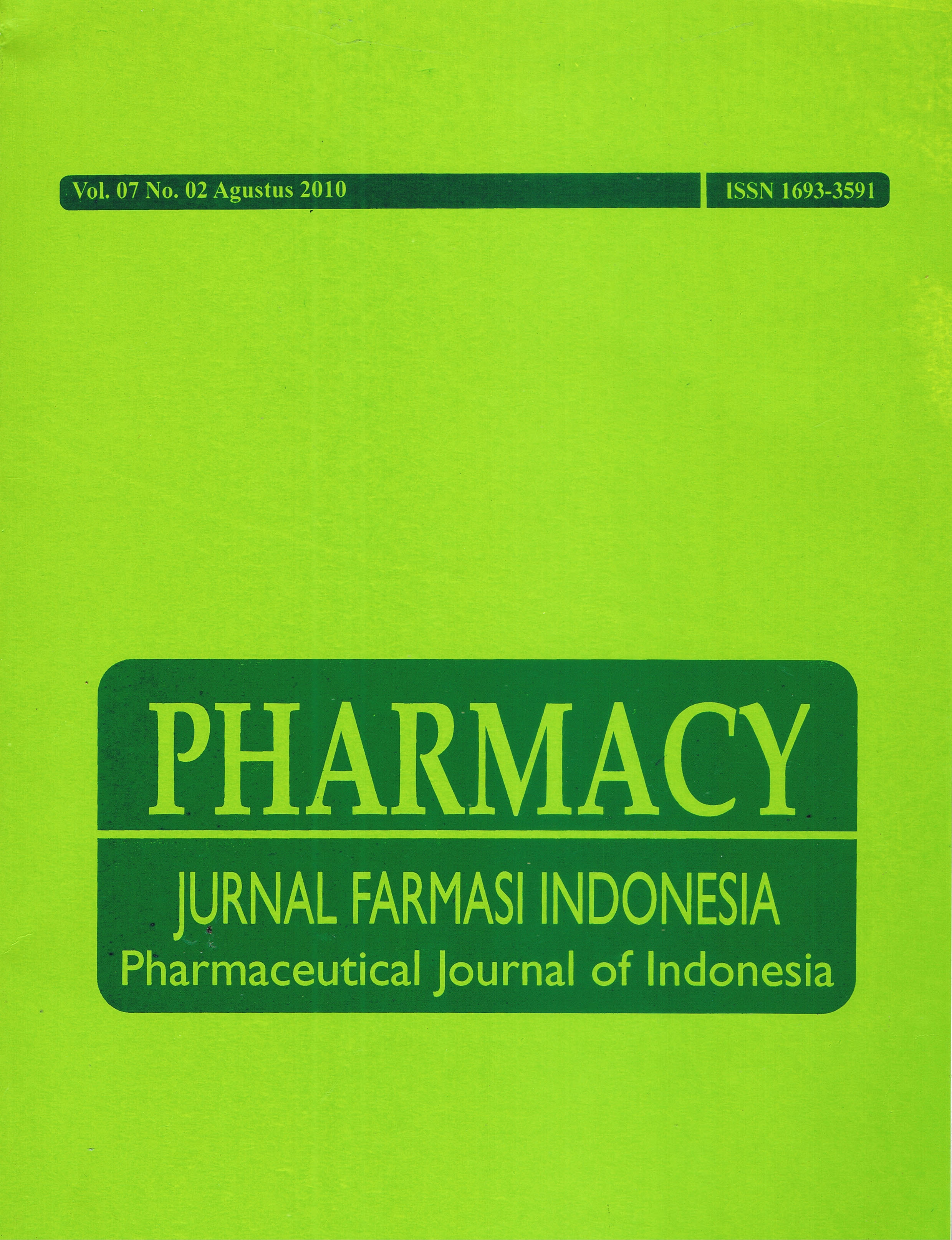FORMULASI GRANUL EFFERVESCENT JAMU PEGAL LINU (RIMPANG TEMULAWAK, RIMPANG JAHE, RIMPANG KENCUR DAN BUAH CABE JAWA) DENGAN KOMBINASI ASAM ASKORBAT-ASAM SITRAT DAN KONTROL KUALITASNYA
DOI:
https://doi.org/10.30595/pji.v7i1.559Abstract
ABSTRAK Pegal linu adalah rasa nyeri pada bagian tertentu yang dapat timbul karena kelelahan setelah bekerja, olah raga, dan sebagainya atau merupakan suatu gejala penyakit seperti masuk angin, pilek, dan sebagainya. Salah satu usaha untuk menjadikan obat tradisional menjadi obat modern adalah dengan membuatnya menjadi sediaan granul effervescent dari ekstrak tanaman obat. Penelitian ini bertujuan untuk mengetahui pengaruh kombinasi asam sitrat dan asam askorbat terhadap sifat fisik granul effervescent dan untuk menentukan formula granul effervescent ekstrak jamu pegal linu yang optimum. Metode ekstraksi yang digunakan adalah maserasi dengan cairan penyari etanol 75%. Granul effervescent ekstrak jamu pegal linu dibuat dengan metode granulasi basah dan metode peleburan. Penelitian dilakukan dengan metode Simplex Lattice Design (SLD) dengan 2 komponen yaitu asam sitrat (Z1) dan asam askorbat (Z2), sehingga diperoleh tiga rancangan formula yaitu FI (100% Z1), FII (100% Z2) dan FIII (50% Z1 dan 50% Z2). Parameter sifat fisik yang digunakan adalah waktu alir (detik/100gram), waktu larut (detik) dan kandungan lembab (%). Berdasarkan metode Simplex Lattice Design (SLD) maka diperoleh persamaan untuk masing-masing parameter tersebut, counter plot dan counter plot super imposed sehingga rancangan formula optimum dapat ditentukan. Kombinasi asam sitrat dan asam askorbat (72%Z1:28%Z2) memberikan hasil waktu alir optimum dengan persentase asam sitrat lebih besar dibanding asam askorbat. Formula granul effervescent dengan persentase asam sitrat 100% (FI) merupakan formula yang optimum apabila dilihat dari waktu larut granul effervescent. Asam sitrat adalah faktor yang memperbaiki waktu larut dan waktu alir granul effervescent. Hasil uji sifat fisik granul effervescent menunjukkan bahwa dari semua formula memenuhi syarat uji waktu alir dan waktu larut, tetapi tidak memenuhi syarat uji kandungan lembab, sehingga tidak diperoleh rancangan formula optimum. Kata kunci: pegal linu, granul effervescent, asam sitrat, asam askorbat, Simplex Lattice Design. ABSTRACT Rheumatic pain is a pain in certain part that can arise because of fatigue after working, sports, etc or is a symptom of diseases such as colds, runny noise, etc. One of effort to make the traditional medicine become modern medicine is by making it to granule effervescent preparation from herb crop extract. Aimed of this research was to find out the effect of combination of citric acid and ascorbic acid on granule effervescent physical characteristic and to determine optimum formula of jamu pegal linu extract granule effervescent. The extraction use maseration with ethanol 75%. The effervescent granule of jamu pegal linu extract made by wet granulation and dissolved method. Research was carried out by Simplex Lattice Design (SLD) Method with 2 components that is citric acid (Z1) and ascorbic acid (Z2), so that obtained three formula design they are FI (100% Z1), FII (100% Z2), and FIII (50% Z1 and 50% Z2). As the parameter of granule effervescent physical characteristic that is flow rate (second/100gram), dissolved time (second) and moist content (%). Based on Simplex Lattice Design Method so it obtained equation of each parameter, counter plot and counter plot super imposed so that obtained the optimum formula design. The combination of citric acid and ascorbic acid (72%Z1:28%Z2) gave optimum result with presentation of citric acid is bigger than ascorbic acid. Formula of granule effervescent with presentation of citric acid 100% (FI) is the optimum formula if looked from dissolved time of granule effervescent. Citric acid is that factor that has effect to improve flow rate and dissolved time of granule effervescent. Physical characteristic test result of granule effervescent indicated that from all formula meet requirement of flow rate test and dissolved time, but not meet the requirement of moist content test, so that not obtain optimum formula design. Key word: rheumatic pain, granule effervescent, citric acid, ascorbic acid, Simplex Lattice DesignReferences
BPOM RI. 2004. Monografi Ekstrak Tumbuhan Obat Indonesia Volume I. Jakarta: Badan Pengawasan Oban dan Makanan RI. Hlm 4, 5, 15, 45, 114, 115
Depkes RI. 1979. Farmakope Indonesia Edisi III. Jakarta: Departemen Kesehatan RI. Hlm 50, 807
__________. 1993. Pedoman Rasionalisasi Komposisi Obat Tradisional. Jakarta: Departemen Kesehatan RI. Hlm 17
__________. 2000. Parameter Standar Ekstrak. Jakarta: Departemen Kesehatan RI. Hlm 9, 10
Diniatik, Wulandari. 2006. Optimasi Ekstraksi Formula Jamu Pegal Linu (Rimpang Temulawak, Rimpang Jahe, Rimpang Kencur, Buah Cabe Jawa) dan Daya Analgetiknya. Journal of Pharmacy.
Lestari, Agatha., 2006, Optimasi Formula Granul Effervescent Ekstrak Temulawak (Curcuma xanthorrhiza Roxb.) Dengan kombinasi Asam Sitrat Dan Asam Tartrat (Aplikasi Metode Desain Faktorial). Skripsi. Fakultas Farmasi Universitas Sanata Dharma Yogyakarta. Hlm 2, 4.
__________. 2007. Optimasi Natrium Sitrat Dan Asam Fumarat Sebagai Sumber Asam Dalam Pembuatan Granul Effervescent Ekstrak Temulawak (Curcuma xanthorrhiza Roxb.) Secara Granulasi Basah. Skripsi. Fakultas Farmasi Universitas Sanata Dharma Yogyakarta. Hlm 23, 24.
Siregar, C. 1992. Proses Validasi Manufaktur Sediaan Tablet. Bandung: FMIPA, ITB. Hlm. 32, 39
Sudarsono et al. 1996. Tumbuhan Obat. Yogyakarta. PPOT-UGM. Hlm 84, 86, 130, 150
Winarto. 2003. Cabe Jawa si Pedas Berkhasiat Obat. Depok. Agromedia Pustaka
Downloads
Published
How to Cite
Issue
Section
License
Authors who publish with this journal agree to the following terms:
- Authors retain copyright and grant the journal right of first publication with the work simultaneously licensed under a Creative Commons Attribution 4.0 International License that allows others to share the work with an acknowledgement of the work's authorship and initial publication in this journal.
- Authors are able to enter into separate, additional contractual arrangements for the non-exclusive distribution of the journal's published version of the work (e.g., post it to an institutional repository or publish it in a book), with an acknowledgement of its initial publication in this journal.
- Authors are permitted and encouraged to post their work online (e.g., in institutional repositories or on their website) prior to and during the submission process, as it can lead to productive exchanges, as well as earlier and greater citation of published work (See The Effect of Open Access).






